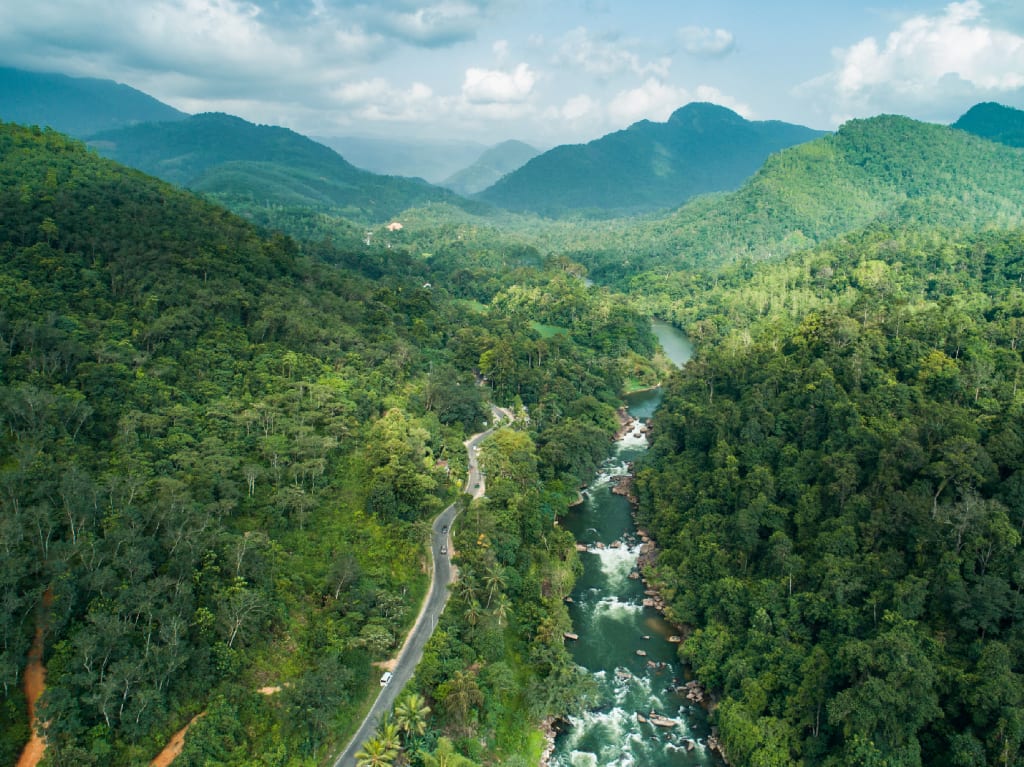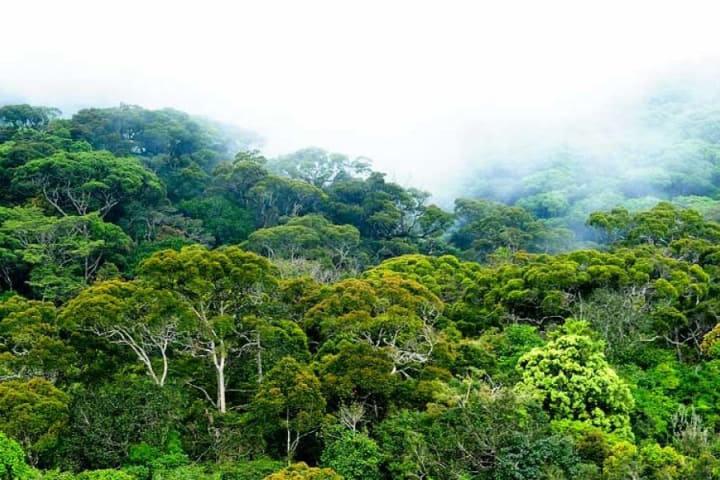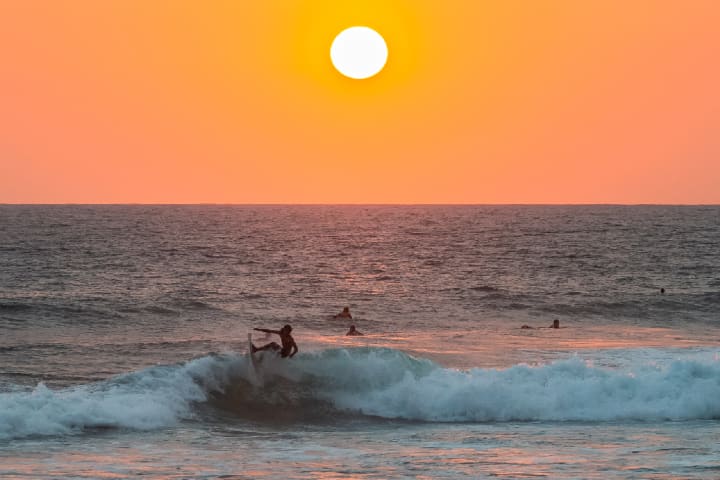
The Kottawa Forest Reserve is located along the major road leading to Udugama Township in the northeast of Galle. Only roughly 37 acres make up this isolated sliver of low country rain forest. However, it possesses every characteristic of a regular rainforest. The vegetation is of the wet evergreen variety, with towering trees straining skyward for sunshine and close-knit canopies blocking sunlight from reaching the forest floor. This woodland is a lush evergreen tropical forest. This woodland, which lies between 50 and 300 meters above sea level, will greet you on both sides of the road.
Upon entering the Kottawa Rainforest, you came across a few little pathways that lead in different directions. The Tea plantation in Down country has one route accessible. There are tea research facilities nearby, and you may observe freshly picked tea leaves there. The visitors find it enjoyable to see everything in one trip. A different footpath leads to a natural water tank. Tourists find this location to be the most alluring. They all go there to take baths. Additionally, Kottawa Rainforest is a lovely bird haven.
It is regarded a climax community, a positive indicator for the continuation of the forest, because the tree bases are buttressed in character and a well-represented understory of plant life composed of the dominant tree species is present. Tree ferns and Dipterocarpus species predominate in the vegetation, and on the towering tree trunks of these species, moss and orchids thrive.

History
This woodland has a past that extends back to World War 2. This woodland served as the location of the British empire's security operations headquarters during World War II. This forest, which spans about 10 hectares and has roughly 72 types of woody plants, is also home to unique animal species. A 38-acre forest park was designated in 1931 for research on this forest, and in 1937 it was given the name Kottawa Forest Park. Kottawa was thereafter given the name Kombala Reserve.

Flora & Fauna
About 170 tree species have been found in the region, of which 100 are unique to the nation. The botanic names of about 80 common tree species have been determined and assigned numbers. Around 70 different bird species, including 12 endemics, may be seen in the Kottawa Arboretum, including the Yellow-fronted Barbet, Brown-capped Babbler, Spot-winged Thrush, Sri Lankan Spurfowl, and Grey Hornbill. Additionally, it is a great location to view some stunning Sri Lankan butterflies (Birdwing, Tree Nymph, Clipper, Blue Oakleaf and more). In the forest's canopy, the Purple-faced Leaf Monkey, Toque Monkey, and Giant Squirrel are the dominant species. Beautiful Sri Lankan non-venomous snakes and unique agamid lizards are among the reptiles that may be found in the region. A variety of freshwater fish are found in the unpolluted streams that run through the forest, the majority of which are indigenous to the nation.

How to Get
Take the Udugama Road out of Galle (B129). The Kottawa Information Center is located on the right, just after the kilometer 13 sign on the B 129. Gates to the left and a sizable yellow signboard that reads "Kottawa Arboretum Wet Evergreen Forest Kottawa Kombala" are located farther down the road, before the 14 km marker. The ticketing center is open from 8:00 am to 5:00 pm. 17 kilometers separate you from Galle.
Destinations near
Sinharaja Rainforest
The Sabaragamuwa and Southern provinces of Sri Lanka contain the rain forest and biodiversity hotspot known as Sinharaja, which is situated in the southwest lowland wet zone. The country's only remaining primary tropical rain forest is located in Sinharaja. 11,000 Ha of primary and secondary woods are present there. This short stretch of hilly terrain is made up of several hills and valleys. More than 60% of the trees in Sinharaja Forest are native to the area, and many of them are unique. There is a lot of endemic wildlife in the reserve, particularly birds, but there are also many different kinds of insects, reptiles, and uncommon amphibians, as well as over 50% of Sri Lanka's endemic butterfly and mammal species. This is one of the key causes behind UNESCO's 1988 declaration of Sinharaja Forest Reserve as a UNESCO World Heritage Site. Sinharaja Forest was initially identified in 1936 as the Island's sole sizable area of natural tropical rain forest.

Galle Dutch Fort
The Galle Fort, located in the Bay of Galle on the southwest coast of Sri Lanka, was first constructed by the Portuguese in 1588 and then completely reinforced by the Dutch beginning in 1649. It is a historical, archaeological, and architectural cultural monument that, although having stood for more than 432 years, still presents well thanks to considerable rebuilding work carried out by the Sri Lankan Archaeological Department.
The population of the fort is multi-ethnic and multi-religious today, and it has a rich past. The Sri Lankan government is looking into making this one of the modern wonders of the world, together with numerous Dutch people who still own some of the homes inside the fort. As a result of its distinctive display of "an urban ensemble which illustrates the interaction of European architecture and South Asian traditions from the 16th to the 19th centuries," the fort has been recognized by the United Nations Educational, Scientific, and Cultural Organization (UNESCO) for its heritage value and has been listed as a cultural heritage UNESCO World Heritage Site under criteria iv.
https://zeloan.blogspot.com/2022/07/galle-fort.html

Madu River Safari
In the Galle District of Sri Lanka, Madu Ganga is situated adjacent to the town of Balapitiya. The name, which can alternatively be spelled "Maduganga" or "Madhu Ganga," means "Madu River." The main road A2 crosses the Madu Ganga river mouth halfway between the two well-known coastal towns of Bentota and Hikkaduwa. This Madu River creates a complex network of mangrove swamps farther upstream, as well as a large open lake studded with islands.
The biggest surviving mangrove swamp in Sri Lanka and an amphibious environment, Maduganga is home to several fish and reptile species. It's a great place to go bird-watching as well. Together with the smaller Randombe Lake, which is located farther south but closer to the coast, and connected to the Madu River by two natural channels, it creates the Madu Ganga Wetland, which is home to almost 250 species of vertebrate animals and more than 300 species of plants. The International Ramsar Convention on Wetlands, a global agreement for the conservation and sustainable use of wetlands, classified Madu Ganga due to its rich biodiversity. The Iranian city of Ramsar, where the Convention on Wetlands was signed in 1971, bears its name.
https://zeloan.blogspot.com/2022/10/madu-river-in-sri-lanka.html

Lankagama
Lankagama is a great destination for those that enjoy the outdoors. It is situated close to the Sinharaja rain forest in Sri Lanka's southern region. Through Deniyaya, travelers may go to Lankagama from Galle.
This is a wonderful location to take in and appreciate Sri Lanka's natural beauty. Lankagama is rich in many waterfalls, kinds of vegetation, animals, tea plantation estates, and distinctive rural lifestyles that leave tourists with unforgettable experiences. Anyone visiting Lankagama will have rejuvenating experiences from these natural buddies to balance out their hectic life.
https://zeloan.blogspot.com/2022/09/lankagama-in-sri-lanka.html

Hikkaduwa
Hikkaduwa is located about 100km south of the Sri Lankan capital, Colombo. The area is well known for its coral sanctuary, the proximity of wonderful scuba diving sites to explore and having a top surfing beach. With its unique beach culture and vibe, Hikkaduwa has long been one of the more popular beach resorts in Sri Lanka. In the center of Hikkaduwa, a protected lagoon creates a beautiful and safe snorkeling area. Further south, where the currents are stronger, surfing is the dominant water activity. The impressive coral reef runs just offshore and is populated by exotic fish and sea turtles that occasionally come ashore to lay their eggs.
https://zeloan.blogspot.com/2022/08/hikkaduwa-in-sri-lanka.html

Hiriketiya Beach
Dikwella, sometimes known as Dickwella locally, is a nearby town that has grown significantly in popularity with tourists traveling to Sri Lanka's south coast. These magnificent coastal communities, which we adore, were made possible by the laid-back way of life and surf vibes at Hiriketiya Beach and Dikwella. It still has that raw, unspoiled feel about it even if it isn't as well-kept a secret as it once was.
This beach is where the forest meets the sea, and palm palms surround the shoreline. Rustic, neighborhood eateries offer beverages right next to the ocean. If a laid-back lifestyle is what you're after, make your way directly to Sri Lanka's Hiriketiya Beach since the laid-back environment is hard to top. This hidden beach has a sleepy feeling.
https://zeloan.blogspot.com/2022/07/hiriketiya-beach-in-sri-lanka.html

Suriyakanda
Visitors to this tiny community are drawn in by the abundance of stunning, remote routes. On Sinharaja's eastern border, a 16 km route connects Rakwana and Suriyakanda. It may be recognized as a region with a warm climate and a misty setting surrounded by stunning mountains. The Little Eighteen Bend is another name for this path that winds through the mountains and through waterfalls over the Springwood Estate. Ten elbow bends on the road, in the midst of tall Russa trees, give it its form.
https://zeloan.blogspot.com/2022/07/suriyakanda-in-sri-lanka.html

Kanneliya Rainforest
The Kannelia - Dediyagala - Nakiyadenia (KDN) Forest Complex includes the Kanneliya Rain Forest. Except for Sinharaja, Sri Lanka's only significant rainforest is the KDN Forest Complex. In 2004, UNESCO declared the Rain Forest Complex as a Biosphere Reserve. One of South Asia's most precious forest resources is Kanneliya. The dominating plant species in the Kanneliya forest is known as the Hora caste. The majority of this forest is still a secondary forest as a result of extensive logging in the past. The Kanneliya woodland has been home to 301 different plant species. 25% of these plant species, which comprise plants, shrubs, and herbs, are unique to Sri Lanka.

Unawatuna Beach
A seaside community in Sri Lanka's Galle district is called Unawatuna. With its beach and reefs, Unawatuna is a popular tourist destination in Sri Lanka. It is a suburb of Galle, located around 108 kilometers (67 miles) south of Colombo and about 5 kilometers (3.1 mi) to the southeast of the city's core. The elevation of Unawatuna is 5 meters (16 feet) above sea level. It is a gorgeous beach with golden sand and blue waves that is shaped like a banana and is bordered by towering palm palms. The beach is a wonderful spot to experience local culture while also cooling down in the ocean after a sweltering summer day.

The Kottawa Forest is the ideal location for a fun trip with your loved ones. You will feel much more at ease in the jungle temple (Aranya Senasana) in the bush. This forest will provide you with valuable experiences in terms of how you feel, what you experience, and what you acquire. To view the future, save this woodland kingdom. Just your exhaled breath is left. Don't leave anything you brought there when you leave the wilderness. Only bring mementos.
Google Map :
https://goo.gl/maps/H1Nq8FTowfHCPLkW6
About the Creator
Zeloan
I'm a Traveller, Blogger, and Content Creator. Visit Sri Lanka, and you can see the most beautiful places in the world and the remarkable hospitality here






Comments
There are no comments for this story
Be the first to respond and start the conversation.